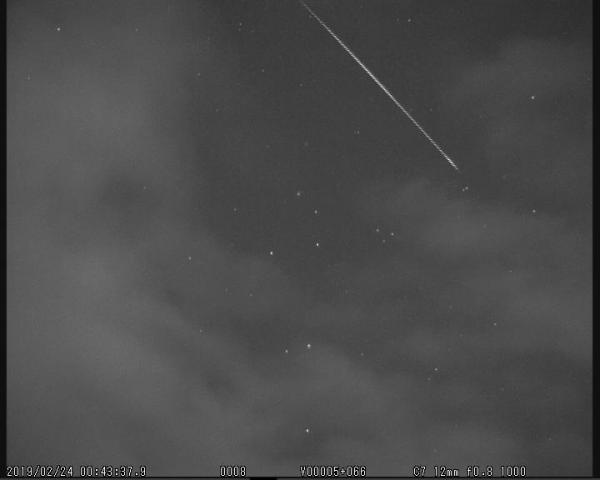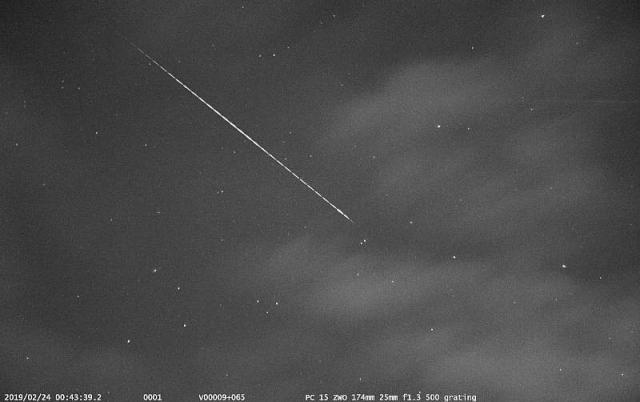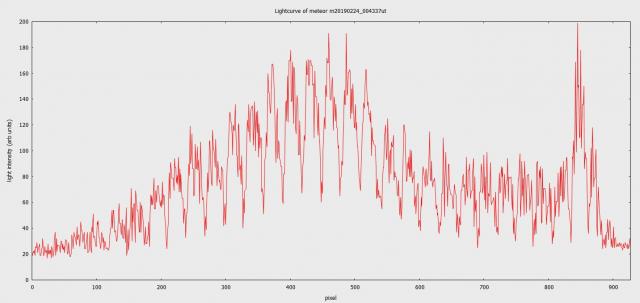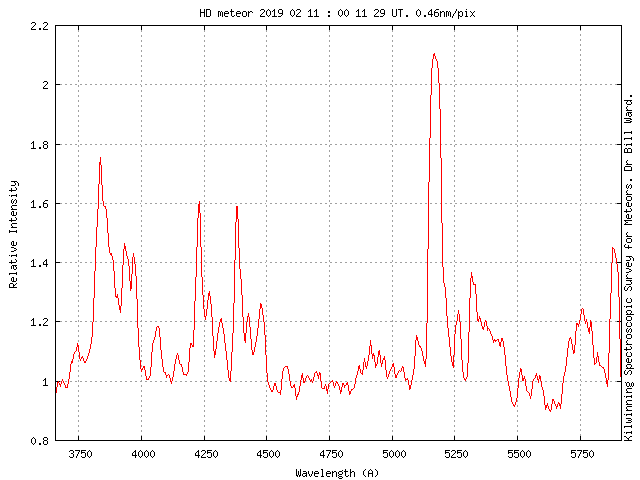Forum Replies Created
-
AuthorPosts
-
 Bill WardParticipant
Bill WardParticipantHi,
Will do, I’m planning on positioning the cameras where we’ve had detection’s before. Even with the bigger chip, using the 25mm lenses gives a slightly smaller FOV than the 12mm’s on the WATEC’s. I’ve got some 12.5mm lenses that will fully illuminate the ZWO chip but there is a magnitude penalty. I might try one of each, as the lenses use the same hood thread sizes so the gratings are effectively interchangeable.
Positive thought…. it WILL be clear on Monday night!
cheers,
Bill.
 Bill WardParticipant
Bill WardParticipantHi,
I cut out some disc’s of plastic grating film and mounted them in little cardboard holders last night. So the system is now good to go. I’m hoping the weather will co-operate so I can get at least one spectrum (of anything…!).
I received an email from Derek with his first spectrum. Taken through this grating film and looking at his results, as with mine, either the meteor was very “blue” or the grating film has indeed better performance in the blue compared to the glass gratings I have used previously.
We’ll see…
cheers,
Bill.
 Bill WardParticipant
Bill WardParticipantHi,
Thanks, with a bit of processing the ZWO174’s are decent performers. However your question is a VERY good one.
The issue is with the drivers. The response I’ve had from some of my Japanese friends is that they are surprised I could get it to work with UFOHD at all! I’m no expert in this field but from what I gather it is to do with the way UFO uses Directshow.
ZWO have continuously updated their camera drivers so something has changed to get it to work. Another issue seems to be the way the USB works. No matter what I do I cannot get the USB3 connection to work without dropped frames and crashing regularly and I can’t set the frame rate. But, and it seems odd to me, if I use an USB2 connection it works absolutely fine but you’re stuck with whatever the pc can crunch through. The global shutter places a high demand on the computer as it’s a lot of pixels to shunt around.
In my setup the native camera driver is running at 17.1fps with 50ms exposures on USB2 (3.3GHz quad cores) BUT UFOHD thinks it’s seeing 25fps… For detection, as you say, it is indeed fine when it’s just the spectrum your after but I think this may affect the velocity determinations and thus everything else downstream orbitwise.
So I would say probably not, but I’m not really sure how it’s actually working and I’ve never tried it so I can’t say for sure…
Cheers,
Bill.
 Bill WardParticipant
Bill WardParticipantHi Derek,
Thanks, Having tried film based spectroscopy for some 15 years I know the difficulties. I never captured a single one!
I was glad to help, it has been an interesting challenge. It always feels good when you finally see it come together and you actually understand what you’re looking at!
Great fun,
Cheers,
Bill.
PS. Will you be attending the BAA weekend in September at Armagh, or perhaps the IMC again, in Germany this year. Looking forward to catching up with you at some point.
 Bill WardParticipant
Bill WardParticipantHi,
I was sent Henry Soper’s remaining original material a while back but I’ve never seen any of Harold’s. It’s quite fascinating to see the differences between the film results and current video systems.
cheers,
Bill.
PS, Had to check. Yes, one of Harold’s photographs is in Neil Bones’ book. I knew I had seen one recently. Do you know what happened to his originals?
I have scanned the ones from Henry, ultimately I’ll send them to the BAA for archiving.
 Bill WardParticipant
Bill WardParticipantHi,
Since I may well have done the same thing, (but realised what was going on and am sticking to that story), I’m keeping it a secret to save their blushes… ;-))
cheers,
Bill.
 Bill WardParticipant
Bill WardParticipantHi,
Well, as I said, all things being equal…
You can see the curvature on the image and if it was this small discrepancy then that’s more lazy than I am! As long as there is no point of inflection along the dispersion then the spectrum can be corrected on the fly provided a few bright lines can be identified.
I’ve tried the method that C. Buil described using images of grids for distortion correction but it’s frankly not worth the trouble at your average meteor spectrum resolution.
Cheers,
Bill.
 Bill WardParticipant
Bill WardParticipantFollowing on from the other thread about astronomy magazines, it is a sad end to a venerable journal.
Maybe some other publisher will take it on and revive it’s standing.
 Bill WardParticipant
Bill WardParticipant…”small number statistics…” I agree!, mmm, lies, damned lies and statistics.
Quite fascinating though…
I can’t remember where but it was a claimed correlation between large meteor showers and rainfall, I don’t think that one stood the test of time.
Cheers,
Bill.
 Bill WardParticipant
Bill WardParticipantHi,
I still use a quite elderly Epson 3170 Photo. This is a general purpose flat bed scanner but it has a built in light source in the top panel and came with a set of film holders (for 35mm mounted/unmounted and 6×6 format). I really like mine.
You can pick them up second hand (ebay etc) quite cheaply now. I’d check the driver software is still available from Epson before you consider buying one, just in case…
Cheers,
Bill.
 Bill WardParticipant
Bill WardParticipantHi All,
I’ve re-fitted three of my cameras with the plastic film grating and re-aligned the various cameras so I get overlapping FOV’s. This, ostensibly, is so I can compare the spectroscopy characteristics of the various camera/lens/grating combinations.
Unfortunately no spectra from last night but the the testing of the ZWO camera continues nonetheless.
Captured a nice bright meteor on one of the WATEC 901HX/RC camera’s

and the same meteor on the ZWO 174MM.

I’ve half sized the ZWO image to try and visually make the images comparable. On screen the ZWO images look very dark but when stretched even just a little they reveal all the data that is really there! The global shutter and slower frame rate/longer exposure give a nice “chopped” image. The glow from trail can even be seen to infill the gaps.
Also the higher native bit depth of the ZWO means the pixels are less likely to saturate. Using the slice function in IRIS a lightcurve can be extracted easily.

…shows the terminal flare nicely.
Cheers,
Bill.
 Bill WardParticipant
Bill WardParticipantThat’s a great result, excellent teamwork! I was pretty sure it was strongly foreshortened, not quite right at me but pretty close. (Also good to know where to point my other spectrum systems!)
I’ve found another small bit of the plastic grating film and I’m now intrigued… I have many spectra with nice lines long-ward of 500nm. I would have thought there would have been some blue lines with the brightness of the meteors but there are none. Ed Majden over in Canada contacted me about some spectra he had that showed the same thing.
I think I’ll change the lens on one of my systems to an 8.5mm and stick some plastic grating on that, see how it goes. Tried this before but clearly need to run it a bit longer!
Cheers,
Bill.
 Bill WardParticipant
Bill WardParticipantThanks,
… slowly stretching the spectra out … ;-))
 Bill WardParticipant
Bill WardParticipantHi,
Outstanding! I hope a few stations got it. To get it to work I had to use USB2 (rather than USB3) then tweak the camera interface until it talked to UFO HD. At 17.1fps (camera setting) and 25fps on UFO HD it runs fine. Oddly if I set UFO HD to the camera rate it was not happy. Lots of dropped frames with USB3 at high frame rates.
Definitely some comms/driver issues so I’ve no idea how this would roll up into the data UFO HD would produce for orbit/analyser but I’ll leave that to the NEMETODER’s… ;-))
To get a decent limiting mag I’m using a 50mS exposure as the pixel pitch is 5.6um. Sensor is 1936 x 1216 pixels.
It’s got potential!
cheers,
Bill.
PS- quick edit, I meant to add there was a hint of the 557.7nm line so I’m betting this’ll be a fast one….
 Bill WardParticipant
Bill WardParticipantAhh -ha! great minds think alike….
BUT I’m afraid not, well not at the moment. This is one of those UFO HD/driver problems. If the camera is set to it’s 2×2 binning (the performance is exceptional) however UFO HD throws up a media mismatch error. I can’t get it to work at the binned frame size at all. HandyAVI will run it fine at 2×2 but that’s not got such a good user interface.
The small pixel size certainly reduces the mag limit but even so, at full res, I can still see +8 stellar on the frames without the grating in the way. So it’s still pretty good and the point is to get as high a resolution as possible. A few more results will show whether it’s a viable instrument comparable to the venerable watec’s.
Bill.
 Bill WardParticipant
Bill WardParticipantHi,
Thanks, I’m planning to leave the plastic grating in place to see how it compare’s to the other gratings. I’ll need to make up a little cardboard holder to make it a bit more secure though.
An interesting little side experiment!
Cheers,
Bill.
 Bill WardParticipant
Bill WardParticipantAfter a bit of processing…

What I think is remarkable is the performance of the cheap plastic grating film. I have had this stuff for decades and cut little bits from the sheet as various projects have come and gone. Might need to invest in some more and do some additional observations.
Some of the more expensive gratings are not so good at the blue end so either this meteor was VERY blue or the plastic grating is better than the glass gratings under some circumstances…
Anyway I’m pleased as I’m now at less than .5nm dispersion on the sensor. Which is pretty good for general meteor observations.

The colourised version illustrates the neutral Mg and H+K Ca lines in the UV resolved. The last little UV bump is an iron line at 374.9nm, that’s not too bad.
Onward’s we stumble…
 Bill WardParticipant
Bill WardParticipantNow there’s a question!, and there’s probably a near infinite number of opinions as to which is best… 😉
PS. …but apart from JBAA of course, The Astronomer…
 Bill WardParticipant
Bill WardParticipantHi,
I often wonder about the progression to grumpy old man status….
This is an excellent example, I subscribed to S+T for decades then I too let it slide a number of years ago. It’s gone from a quite superior magazine with technically interesting articles (some even had formula!) to positive mediocrity. I decided to buy a CD compilation of all the past editions and the difference decade to decade is clear (I think so anyway).
Oh well, I suppose that’s what called progress….
Cheers,
Bill.
 Bill WardParticipant
Bill WardParticipantHi,
Yes (ish)… Full tracking is way beyond my progamming skills but I think using a rotating mirror system one could build something that would at least “slow” them down along one axis. That would certainly help but then there is still the coverage issue.
Probably my only regret leaving the university is not having access to an optical lab and workshop where I can experiment anymore.
cheers,
Bill.
-
AuthorPosts
